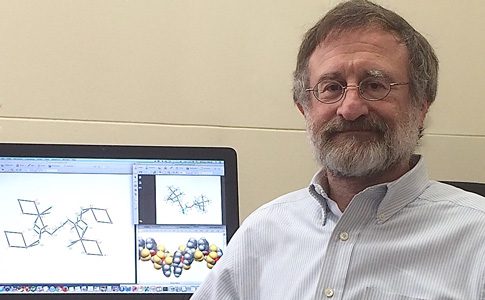Faculty Info
Name: William Howard Hersh
Title: Professor
Department: Chemistry and Biochemistry
Degree(s): PhD, Chemistry, Columbia University; BS, Chemistry, Yale University
Contact Information:
Phone: 718-997-4144
Office: 109 Remsen Hall
Email: william.hersh@qc.cuny.edu
“Hersh says he still enjoys getting unexpected results in the lab. “But when my students get the unexpected results, I let them try and figure it out first.”
– William Howard Hersh
Past Profiles

Building Futures: William Hersh
How Scientists Are Made
Before he was 10, Professor William Hersh (Chemistry) was taking apart and rebuilding broken lawnmowers, radios and other electronics with the encouragement of his father, who had served as an engineer during World War II. “He also brought back microscopes from the war—probably from an abandoned facility—and I’d look at amoeba from nearby streams. Biology and electricity were my first interests,” Hersh says.
By the time he was a teenager, Hersh was ordering engines by mail and building rockets to send skyward at the beach. But it was a gifted chemistry teacher at Verona High School in New Jersey who sparked his interest in the subject.
“I was probably in tenth grade when I built a lab in our garage,” recalls Hersh, who obtained what he needed from a chemical supply house. Some of the chemicals were toxic and others explosive. “It’s bizarre to think of what you could buy then,” he says. Fortunately, the budding scientist exercised due caution in his experiments, and no fire trucks had to be called.
An NSF-sponsored summer program for high school juniors gave Hersh the chance to immerse himself in chemistry at Bucknell University. That experience confirmed his passion for the subject to which he has devoted his life as a teacher, researcher and mentor of aspiring scientists.
Hired in 1989, Hersh recently entered his 30th year of teaching in the QC chemistry department. Last November the prestigious American Association for the Advancement of Science (AAAS) named him a Fellow, a lifelong title. This honor, which the AAAS has awarded to such famous high-achievers as Thomas Edison and Linus Pauling, recognizes Hersh “for research expertise in organic, organometallic, computational and biological chemistry, for mentoring over 80 research students, and for building his department…” He will attend the D.C. ceremony on February 16 with his wife, Carol Hersh, who also holds a PhD in chemistry.
Over the years, Hersh has published scores of articles in professional journals, presented internationally and nationally at conferences and Ivy League universities and obtained many grants, including two from the NSF, one from the NIH, 24 from PSC-CUNY and several from QC for undergraduate research and mentoring. He is also proud of bringing to his department not one but two NMR spectrometers used to analyze molecular structure, one purchased in part through an NSF grant.
Because his research is technical, it can be difficult to explain to laymen which, he concedes, is “a big challenge.” But for the past two years, Hersh has been researching drug delivery for gene therapy, a potentially life-saving treatment that’s gained awareness among the general public.
With the onset of the HIV crisis, Hersh began to look at DNA synthesis and how it can be used to block the formation of disease-causing proteins, research that continued for 15 years. It wasn’t until late 2017 that the first gene therapy drug was approved in the U.S., used to treat an inherited disease that causes blindness.
“Viruses, including engineered, non-toxic viruses, have proteins that can deliver the gene into the nucleus of cells, which is needed for gene therapy to work,” Hersh explains, “but now chemists are trying to develop non-viral gene therapy, which would open up the treatment to more people. To demonstrate the result, we need to collaborate with biologists,” he says. “It’s an exciting and very competitive field.”
Describing himself as “hands-on,” Hersh says he still enjoys getting unexpected results in the lab. “But when my students get the unexpected results, I let them try and figure it out first.”
His greatest satisfaction? The students themselves. Not just postdoctorals, master’s and PhD students have worked in his lab, but nearly 60 undergraduates have also conducted research with Hersh, some benefitting from Howard Hughes Fellowship funding obtained by the department. “I love seeing students learn how to be researchers and go on to PhDs and great jobs. They have such interesting stories, and it’s fun for me to get to know them as people,” says Hersh.
He cites just a few examples: one 1995 graduate, Cheslan Simpson, applied to QC from the island of Jamaica and went on to earn a PhD and run the high-security Nuclear Detection and Deterrence unit at Pacific Northwest Lab. A 2018 grad, Shah Khan from Pakistan, had driven a cab while a student to help support his parents. He is applying to medical school. And recent graduate Mossa Ghattas, who arrived from Egypt not speaking English, worked as a garage attendant and is now enrolled in the PhD program in chemistry at the CUNY Graduate Center, where Hersh also serves on the faculty.
On the anniversary of 9/11, if classes are held, Hersh always tells the story of undergraduate Salman (“Sal”) Hamdani, a Muslim American who worked in his lab for three years. A former ambulance driver and New York City police cadet, Hamdani rushed downtown the day of the attack and disappeared. Rumors of a possible terrorist connection circulated; flyers with his photo were posted announcing that he was wanted for questioning–until his body was found in the rubble six months later. The NYPD honored Hamdani as a first-responder hero, and his mother established a QC scholarship in his name.
“Sal had contributed to one of our research projects, and his name was included on the paper we later wrote and submitted to the Journal of Organic Chemistry. It was published posthumously,” says Hersh, who will clearly never forget this young man.

